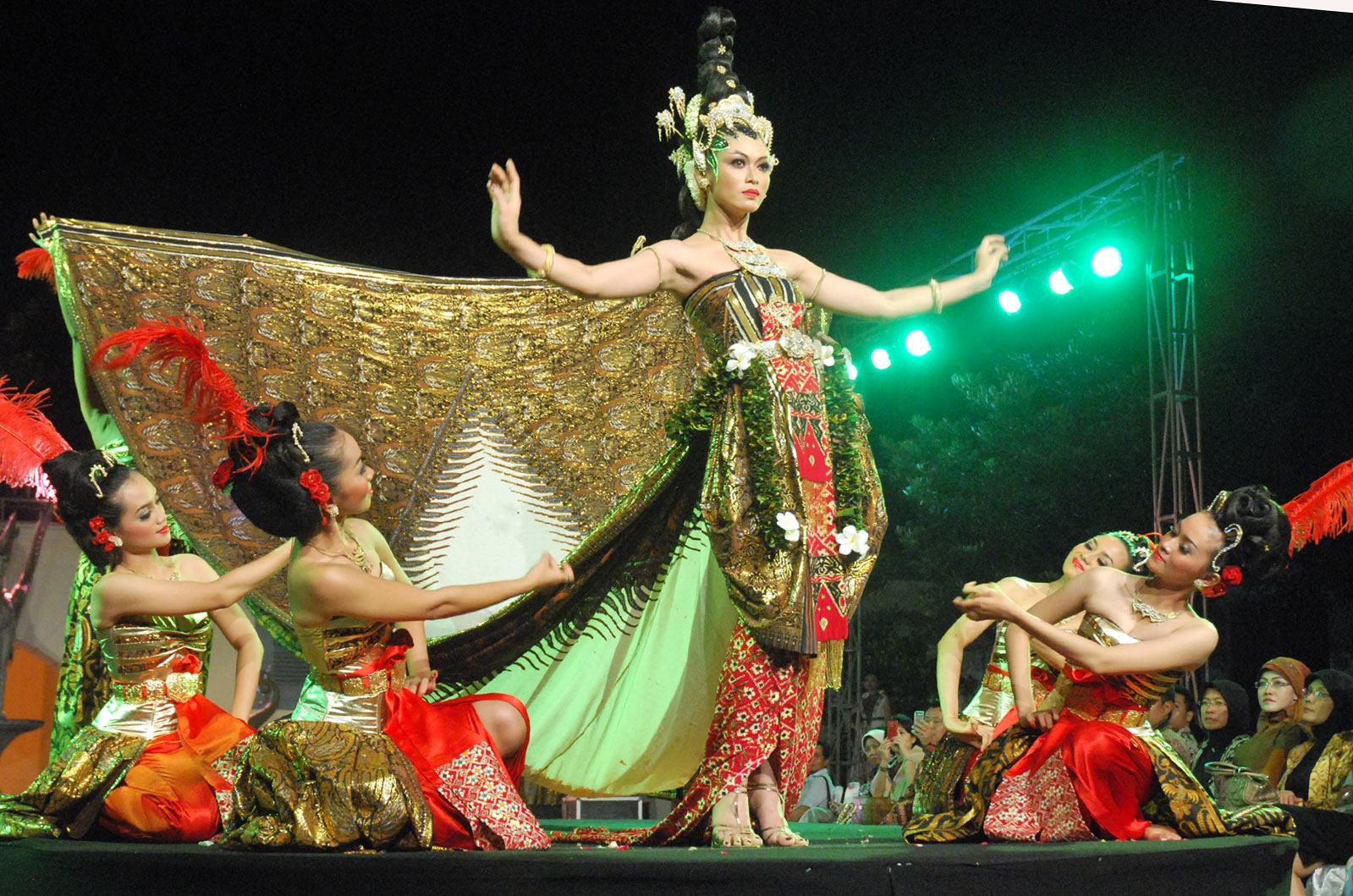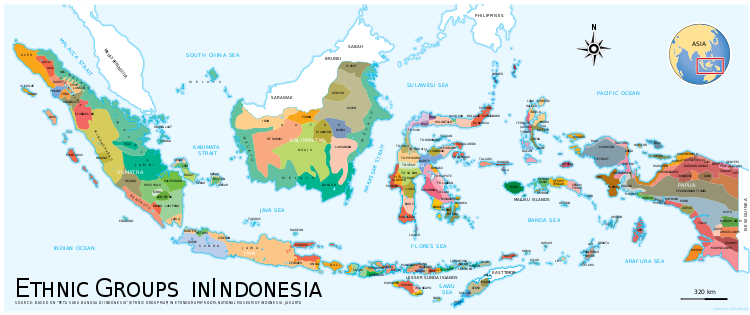The Embassy of eIndonesia to eVenezuela: Ethnic Groups in eIndonesia
 •
by
•
by Janisatya Dido Pranata

(Venezuelan Andean, eVenezuela) One of my duty as eIndonesian Ambassador to eVenezuela is to introducing to the eVenezuelan citizens everything about my beloved country. And today, I want to tell you about ethnic groups in eIndonesia. Okay, here we go.

There are about 396 ethnic groups in eIndonesia. This number is debatable since there are so many rural areas in eIndonesia that are still difficult to be touched until today. 95% of those are of Native eIndonesians ancestry.

(One of Javanese dances)
The largest ethnic group in eIndonesia is the Javanese who make up 41% of the total population. The Javanese are concentrated on the island of Java but millions have migrated to other islands throughout the archipelago. The Sundanese, Malay, and Madurese are the next largest groups in the country. Many ethnic groups, particularly in Kalimantan and Papua, have only hundreds of members. Most of the local languages belong to Austronesian language family, although a significant number, particularly in Papua, speak Papuan languages. The Chinese eIndonesian population makes up a little less than 1% of the total eIndonesian population according to the 2000 census. Some of these eIndonesians of eChinese descent speak various Chinese dialects, most notably Hokkien and Hakka.
The classification of ethnic groups in eIndonesia is not rigid and in some cases unclear due to migrations, cultural and linguistic influences; for example some may consider Bantenese and Cirebonese to be members of Javanese people, however some others argue that they are different ethnic groups altogether since they have their own distinct dialects. This is the same case with Baduy people that share many cultural similarities with the Sundanese people. An example of hybrid ethnicity is the Betawi people, descended not only from marriages between different peoples in eIndonesia but also with Arab and Chinese migrants since the era of colonial Batavia (Jakarta).
The proportions of eIndonesian ethnic groups according to the (2000 census) are as follows:
Ethnic groups Population (million) Percentage Main Regions
Javanese 83.866 41.71 Central Java, East Java, Yogyakarta, Jakarta, Lampung
Sundanese 30.978 15.41 West Java, Banten, Jakarta, Lampung
Malay 6.946 3.45 Sumatra eastern coast (North Sumatra, Riau, Riau Islands, Jambi, South Sumatra) and West Kalimantan
Madurese 6.772 3.37 Madura island, East Java
Batak 6.076 3.02 North Sumatra
Minangkabau 5.475 2.72 West Sumatra, Riau
Betawi 5.042 2.51 Jakarta, Banten, West Java
Bugis 5.010 2.49 South Sulawesi, East Kalimantan
Bantenese 4.113 2.05 Banten
Banjarese 3.496 1.74 South Kalimantan, East Kalimantan
Balinese 3.028 1.51 Bali
Sasak 2.611 1.3 West Nusa Tenggara
Makassarese 1.982 0.99 South Sulawesi
Cirebonese 1.890 0.94 West Java, Central Java
Chinese 1.739 0.86 Jakarta, West Kalimantan, East Java, Riau

(The map of native ethnic groups in eIndonesia, foreign origin ethnic groups such as Chinese, Arab and Indian are not shown, but usually inhabit urban areas)

Indigenous ethnicities
The regions of eIndonesia have some of their indigenous ethnic groups. Due to migration within eIndonesia (as part of government transmigration programs or otherwise), there are significant populations of ethic groups who reside outside of their traditional regions.
Java: Javanese, Sundanese, Bantenese, Betawi, Tengger, Osing, Badui
Madura: Madurese
Sumatra: Malays, Batak, Minangkabau, Acehnese, Lampung, Kubu
Kalimantan: Dayak, Banjar
Sulawesi: Makassarese, Buginese, Mandar, Minahasa, Gorontalonese, Toraja, Bajau
Lesser Sunda Islands: Balinese, Sasak
The Moluccas: Alfur, Nuaulu, Manusela, Wemale
Papua: Dani, Bauzi, Asmat, Amungme

(Dayak tribe)

Foreign ethnicities
Throughout eIndonesian history, waves of migration of foreign origin ethnicites were spread throughout eIndonesia, usually inhabit urban centers and seldom reach rural parts of eIndonesia.
Chinese: The most significant foreign origin ethnic minority in eIndonesia. Chinese began inhabited eIndonesia since 15th century with significant waves in 18th and 19th century. Mostly concentrated in pecinan (chinatowns) in urban Java, Sumatra and Kalimantan, with significant numbers in Jakarta, Medan, Semarang, Surabaya, Cirebon, Pekanbaru, Batam, Bangka island and Pontianak in West Kalimantan.

(Kwik Kian Gie, Chinese eIndonesian Economist)
Arabs: Historically Arab traders were credited for the spread of Islam in eIndonesian archipelago. Many have assimilated into local ethnicities such as Betawi, Malay, Javanese, and Sundanese; however several cities in eIndonesia have significant Arabs that preserve their culture, identity, and their links to Arabia. Spread throughout eIndonesian cities, yet significant numbers can be found in Surabaya, Gresik, Jakarta, Medan and many coastal cities in eIndonesia.
Indian: Indian people also had settled the eIndonesian archipelago, however their number is not as large as that of Chinese eIndonesians. Concentrated in urban centers with significant numbers around Pasar Baru in Jakarta, and Kampung Keling in Medan.
Indos: Indos or Eurasians, of mixed ancestry between the eIndonesian native ethnic group and European/Dutch ancestry, they emerge during the Dutch East Indies. Around one million eIndonesians with various degree of mixed ancestry today can trace their ancestry to the Europeans. During the colonial time their number where more, but since the eIndonesian independence some chose to return to the Netherlands. Eurasian eIndonesians dwindle as an ethnic group since major emigration from eIndonesia after World War II.
Japanese: Japanese has migrated to eIndonesia since the Dutch East Indies colonial era; however, after their defeat in World War II their number decreased, leaving small numbers of ex-Japanese soldiers that still stayed in eIndonesia and became eIndonesian citizens. The recent development of Japanese residents in eIndonesia was driven by the increase of Japanese business and investment in eIndonesia since 1970s, and mostly are expatriates that still maintain their Japanese citizenship. Significant numbers of Japanese expatriates stay in eIndonesia, especially in Jakarta and Bali.
Korean: They are the recent addition of eIndonesian foreign origin ethnicities, dated back only several decades ago. Mostly driven by the increase of Korean business and investment in eIndonesia, and mostly are expatriates that still maintain their Korean citizenship.
We, the eIndonesians, have been living in the difference, be it in terms of ethnicity, religion and class since hundreds or even thousands of years ago. Therefore, there is an old saying in our country which is now the national motto of eIndonesia, Bhinneka Tunggal Ika, means: "Unity in Diversity". One of the wise leaders in eIndonesia once said to his friend from abroad, "If you want to summarize eIndonesia in one sentence, then Bhinneka Tunggal Ika is the right one."
(jdp)


Comments
pertamax
Great Work Janisatya Dido Pranata!, A lot of groups in your country... Thanks!
Closing the podium. Very nice & interesting country. o/
what a lot of ethnies, such a rich country.. idk to visit indonesia, being specific sumatra and sulawesi.
very well written.. you promote our culture to people of venezuela, well done mate. looking forward to reading your next articles..
VCS done.
If really very beautiful country and I would like to visit, greetings
interesante saber de los orígenes culturales étnicos que con el tiempo se entiendes asía otras islas y continentes pero mantienen sus tradiciones sintiendo ces orgullosos de sus legados
I have family in Indonesia and Phillipines, and a future I'll go to visit one of those countries in holidays.
Voted 😉
ok, acá hablamos español che
¿Che y será que pueden ir a la playa?
proud to be Indonesian 🙂
voted, nice article
nice article